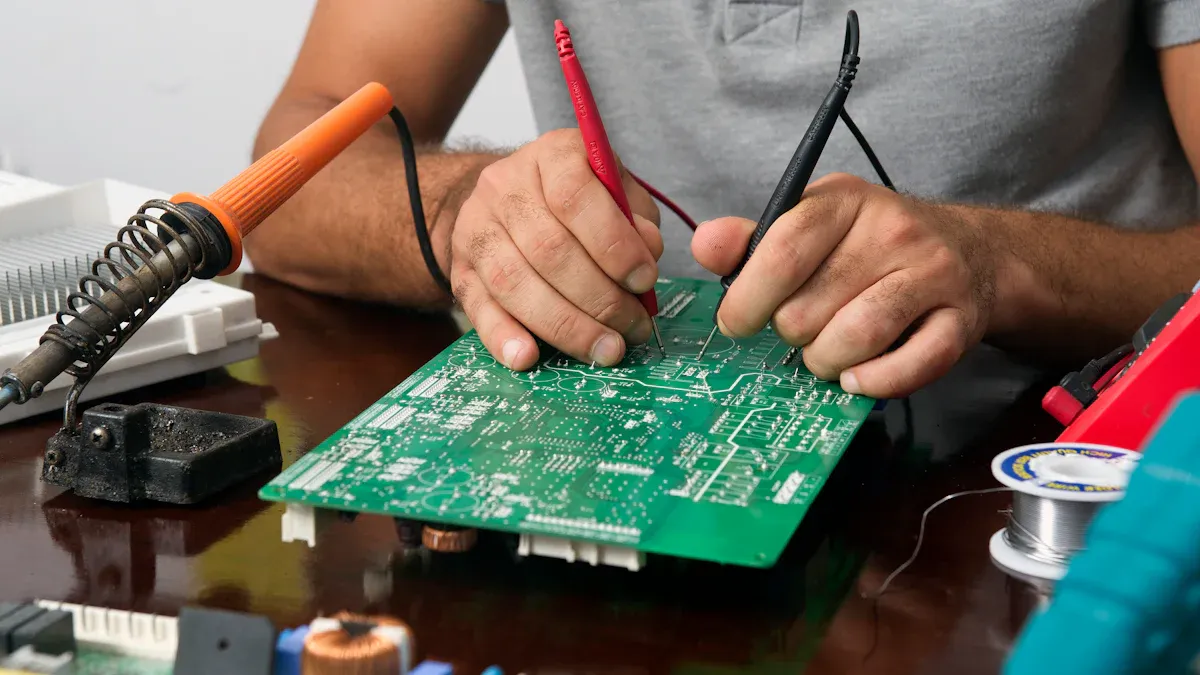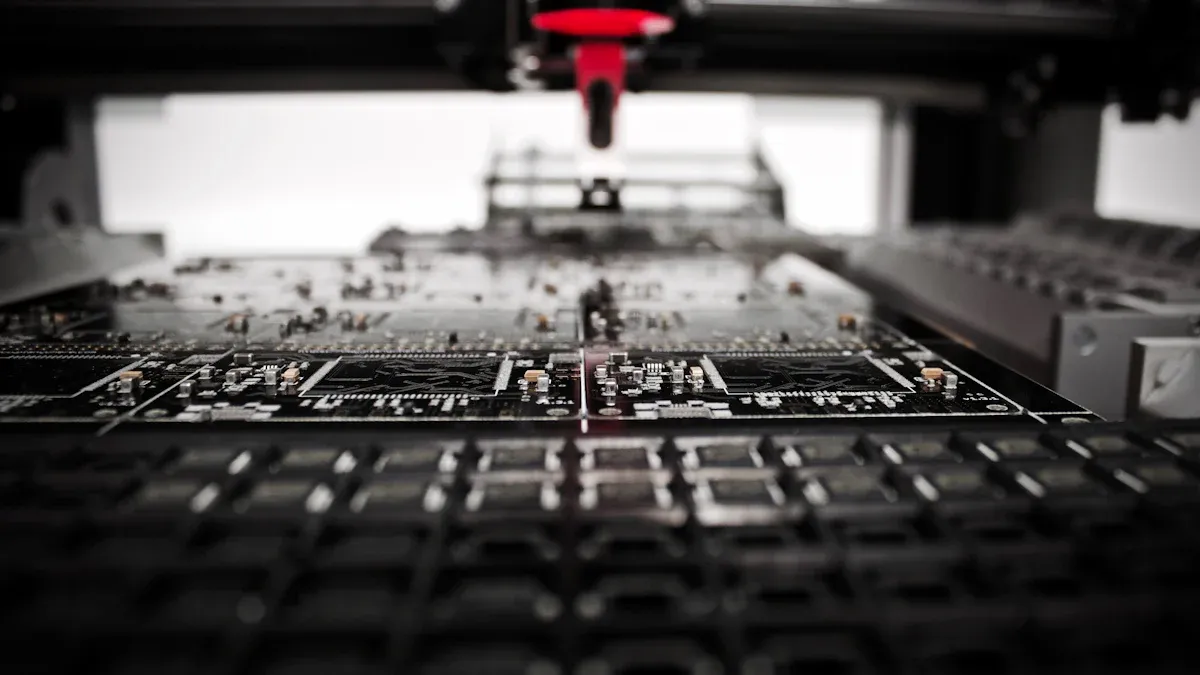The significance of the First Article Tester for SMT assembly and processing

The first article tester is very important in SMT assembly. It finds mistakes early and keeps things running smoothly. Here’s how it ensures good quality:
A strong process gets a capability index (Cpk) of 2.0 or higher, showing great accuracy.
Less than 10% change in results means the production line is steady.
Modern inspection tools help find defects and improve precision.
This tool makes production easier and meets strict rules.
Key Takeaways
The First Article Tester finds errors early. This ensures good products and lowers costs in SMT assembly.
Doing First Article Inspection helps follow strict rules. It builds customer trust and makes your reputation better.
Tools like CMMs and 3D scanners make checks more accurate. This helps production run more smoothly.
Understanding the First Article Tester in SMT Assembly

What is a First Article Tester?
A first article tester is a special tool for SMT assembly. It checks if the first product meets design and quality rules. This tool ensures every part and step matches the plan. By catching mistakes early, it saves money and keeps production smooth.
The tester examines the first product, called the "first article." It checks size, materials, and how well it works. This makes sure the product is good before making more. Industries like aerospace, medical, and car electronics use this tool to keep high standards.
The role of First Article Inspection in quality assurance
First article inspection checks if the product meets all rules. It helps find problems early in the process. This step ensures the product matches designs and customer needs.
Some benefits of first article inspection are:
Making sure all rules are followed.
Setting a plan for steady production.
Finding issues like worn tools or repeated mistakes.
This process proves the methods used make good products. If designs or processes change, it checks if quality stays high. This stops bad products from being made and keeps quality strong.
How First Article Assembly ensures production accuracy
First article assembly improves accuracy by checking the first product closely. It looks at size, materials, and how parts work together. This ensures everything fits and works as planned.
The results, like the First Article Inspection Report (FAIR), give key details. FAIR shows if the product meets all rules. It includes checks on size, materials, and tests. This process reduces mistakes and ensures the product is made right.
Data shows more companies are using first article testing. For example, over 65% of companies in Germany and North America use it due to strict rules. In places like Vietnam, cost matters more than quality, so fewer use it.

Using first article assembly helps make better products, lowers mistakes, and improves quality.
Key Benefits of the First Article Tester in SMT Processes

Reducing errors and defects in SMT assembly
The first article tester helps lower mistakes in SMT chip work. It checks the first product to ensure machines are set up right. This step reduces problems like misplaced parts or bad soldering. It also makes switching between production runs faster and easier.
Using this testing saves money by catching errors early. Automated systems find mistakes before they become costly. It ensures PCBs follow design rules and meet quality standards. This improves product quality and makes the assembly process better. By studying the results, you can fix issues and improve production.
Tip: Finding mistakes early saves time and money in pcba work.
Ensuring compliance with industry standards and customer requirements
Industries like aerospace, cars, and medical devices need high-quality products. First article inspection (FAI) ensures parts meet strict rules and customer needs. This is crucial where even small mistakes can cause big problems.
FAI gives proof that products meet standards like AS9102 or ISO 9001. This proof is important for audits and tracking quality. Adding FAI to your process shows you care about meeting rules and customer trust. It also boosts your reputation in the pcb assembly field.
Enhancing production efficiency and minimizing costs
First article testing improves production by spotting problems early. Fixing issues before full production saves time and keeps things running smoothly. It also cuts waste since fewer bad products are made.
This testing saves money by catching errors early in smt chip work. It avoids costs from fixing or throwing away bad products. The data from testing helps improve processes, saving money over time. This tool is key for making great pcba products while keeping costs low.
Note: Using first article testing boosts efficiency and ensures top-quality products.
Using First Article Testing with LTPCBA
Steps to add First Article Testing to SMT workflows
Adding first article testing to SMT workflows needs a clear plan. First, figure out what data is needed for testing. Make sure your team knows how the testing works. Then, get the production line ready by checking machines and parts. This step ensures the first product matches the design.
After setup, use an automated inspection machine to check the first product. The machine creates a report with details about size, materials, and how it works. Look at this report to see if it meets rules and customer needs. Write down the results and make changes to improve the process if needed.
Tools and technology used in First Article Inspection
Modern tools make first article inspection faster and more accurate. Machines like CMMs, 3D scanners, and digital tools help a lot. These tools improve speed and accuracy during the testing process. CAD and CAM systems also make inspections better by giving more control and precision.
Innovation Type | What It Does |
|---|---|
Measurement Tools | CMMs, 3D scanners, and digital tools improve speed and accuracy. |
Historical Background | FAI started in WWII to meet strict aerospace and defense needs. |
Digital Systems | CAD and CAM systems make inspections more precise and controlled. |
Using these tools helps make better products and improves the pcb assembly process.
LTPCBA’s skill in First Article Assembly and quality checks
LTPCBA is great at first article assembly and quality checks. They use advanced machines to give accurate and trusted results. With a 99.5% success rate, LTPCBA ensures your pcb assembly meets top standards.
The LTPCBA team knows how important first article inspection is for quality. They carefully check everything, from materials to how the product works. This reduces mistakes and keeps the process smooth. Working with LTPCBA gives you access to the best tools and a team focused on doing excellent work.
Overcoming Challenges in First Article Testing
Common problems when using First Article Testers
Adding a first article tester can bring some problems. One issue is not training your team well. Without training, workers may not use the tester correctly. Another problem is the time it takes for inspections. If not planned, it can slow production. Older systems may also not work well with new testers.
Collecting data can be tricky too. If measurements are not steady, quality checks become harder. These problems might seem tough, but fixing them early makes things easier.
Simple ways to improve First Article Inspection
To fix these problems, start with good training. Teach your team how to use the tester and read results. Automating some steps can save time and avoid mistakes. For example, tools like 3D scanners give exact measurements.
Make clear rules for the process to keep it steady. Update your tools and software often to match new systems. These actions make inspections faster and improve pcba work.
Ways to keep improving for long-term success
To succeed long-term, keep improving your process. Use tools like statistical process control to spot problems early. Root cause analysis helps find why mistakes happen and fix them for good. Adjusting printing settings ensures solder paste is applied evenly.
Predictive maintenance is also helpful. It uses data to plan repairs before machines break. These steps lower mistakes, improve quality, and save money over time.
Strategy | How It Helps |
|---|---|
Finds problems early by tracking changes in the process | |
Root Cause Analysis | Shows why mistakes happen so they can be fixed |
Adjusting Printing Settings | Makes sure solder paste is applied evenly |
Predictive Maintenance | Plans repairs before machines break, avoiding delays |
Better Quality Checks | Fixes printing mistakes quickly to keep solder paste consistent |
Fewer Mistakes and Repairs | Reduces errors, so fewer fixes are needed after assembly |
Saves Money Over Time | Cuts waste, lowers costs, and improves production efficiency |
By using these ideas, your pcba process can stay strong and reliable.
Best Practices for First Article Testing in SMT Assembly
Setting clear rules for First Article Inspection
Start by making clear rules for first article inspection. Check all materials and parts used in pcb assembly. This includes base materials and electronic parts to ensure they meet quality standards. Careful checks at this step help avoid mistakes later.
Follow industry rules like AS9102, IPC-A-610, and IPC-6012. These rules help keep pcba processes consistent and high-quality. Use a step-by-step method, like reviewing the Bill of Materials (BOM), assembly drawings, and Gerber files. This makes the inspection process easier.
Component/Process | What It Does |
|---|---|
BOM | Lists materials for checking during assembly. |
Assembly Drawing | Shows where parts go for correct placement. |
Coordinates File | Helps create the Pick-and-place program. |
Gerber Files | Designs solder paste stencil for assembly. |
By following these steps, your first article assembly will meet customer and industry needs.
Using advanced tools and software for testing
Modern tools and software make first article testing more accurate. Machines like Coordinate Measuring Machines (CMMs) and 3D scanners give exact measurements. These tools find problems early and ensure the first product matches the design.
Automated systems save time and reduce mistakes. For example, Automated Optical Inspection (AOI) tools quickly spot soldering or part placement issues. Adding these tools to your process improves speed and keeps quality steady in pcb assembly.
Working with LTPCBA for better First Article Assembly
Teaming up with LTPCBA can improve your first article assembly. They are experts in pcba and have a 99.5% success rate. LTPCBA uses advanced tools and strict rules to ensure top-quality results.
Their process includes checking materials and testing how the product works. This lowers mistakes and keeps production smooth. By working with LTPCBA, you get access to great tools and a skilled team. This partnership helps you make high-quality products and keep customers happy with your pcb assembly projects.
The first article tester is key for quality in SMT assembly. It finds mistakes early to improve accuracy and meet customer needs. Working with LTPCBA gives you great tools and expert help. This ensures your PCB assembly process stays excellent and successful over time.
FAQ
Why is FAI important in SMT assembly?
FAI checks if the first product meets design rules. It finds mistakes early, helping keep quality high and meeting customer needs.
How does FAI make production better?
FAI lowers mistakes by checking the first product carefully. It saves time and materials, making the SMT assembly process smoother and more efficient.
Can LTPCBA help with FAI setup?
Yes, LTPCBA is skilled in FAI. They use advanced tools and a trained team to ensure accurate checks, helping you create top-quality PCBs.
See Also
Understanding SMT And DIP Assembly For PCBA Processes
Key Considerations In SMT Assembly For Rigid-Flex PCBs
Evaluating Standard AOI Versus Online AOI In SMT Assembly
Examining Welded End Designs Of SMC And SMD Components
Effective Strategies For Optimizing SMT Lines In PCBA Production
